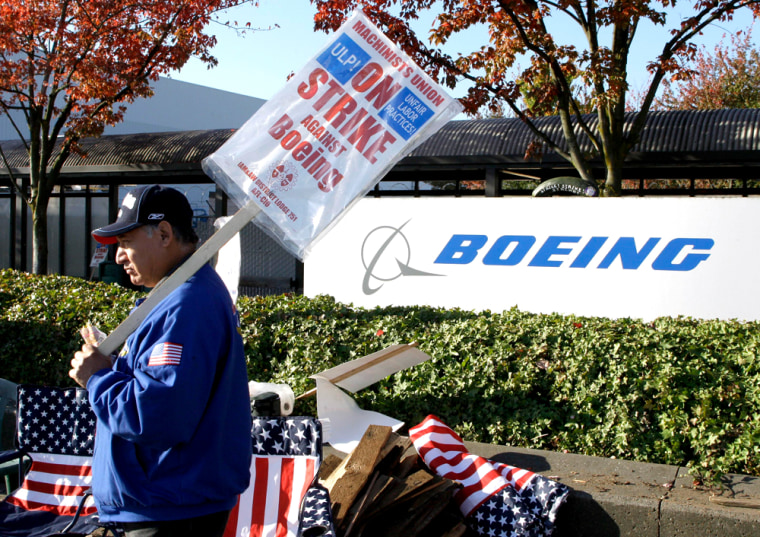When Boeing's biggest union voted to go on strike Sept. 3, the economy was slowing but financial markets seemed relatively calm.
But in the eight weeks that 27,000 Machinists have been walking the picket lines and huddled around burn barrels, the world has changed.
Now Boeing and union leaders are anticipating restarting the company's stalled commercial airplane production lines, but it will hardly be business as usual.
"What the strike has done is allow us to sit on the edge of our seats awaiting word on what the financial crisis means to Boeing,"’ said analyst Joe Campbell with Barclays Capital. "The trouble with this strike is the world is different now."
Boeing executives and union leaders reached a tentative agreement on a new contract late Monday, and assembly lines could restart as early as next week if union members vote to ratify the contract Saturday.
That would end the union's fourth strike against the company in two decades.
But in the meantime, the financial rug has been pulled out from underneath Boeing’s airline customers, parts suppliers and other partners worldwide. A global credit squeeze raises questions about how carriers will finance new airplane purchases, while an expected deep recession will cut into travel demand.
Amid a broad financial market downturn, Boeing’s stock hit its lowest point in more than four years this month on concerns about the market for new commercial jets.
Goldman Sachs analyst Richard Safran lowered delivery forecasts for Chicago-based Boeing to 462 aircraft in 2009 and 392 in 2010, compared with earlier estimates of 489 and 524.
"We believe that the inability to obtain financing will cause customers to defer or cancel orders," he wrote in an investor note. "As a result, we believe (Boeing) will lower production rates."
Safran wrote that 40 percent of Boeing's backlog is scheduled to be delivered to customers that have a below-investment-grade rating, based on a Goldman Sachs analysis. The revised delivery estimate "assumes nearly all customers below investment grade will be unable to obtain financing themselves," according to Safran.
Goldman Sachs cut its earnings projections to $6.45 per share from $6.80 per share for 2009 and $6.30 per share from $7.35 for 2010. It also lowered its 12-month price target for Boeing shares to $40 from $56.
Boeing shares are down about 50 percent from their 52-week high of nearly $99.
Boeing executives so far have said little about how the company is being affected by the financial crisis.
Boeing’s chief financial officer, James Bell, said earlier this month the company should be able to resume pre-strike production levels within two months. “Hopefully we can do it in a lot less time,” he said in a conference call.
Boeing has said its third-quarter net income dropped 38 percent because of the strike and other production issues.
The company also has said it might have to finance the delivery of some airplanes in 2009, because of the credit crunch — a practice Boeing has not done in several years.
But now that the strike appears to be over, investors want more details. As one industry observer put it: “Boeing’s hall pass has expired.’’
Boeing halted all commercial airplane production after the Machinists in Washington state, Oregon and Kansas walked off the job Sept. 5.
Boeing usually gets paid upon delivery, so the stoppage cost the company about $100 million in lost revenue a day. The walkout also has further delayed the new 787 Dreamliner, which already is at least 15 months behind schedule and was supposed to fly for the first time in November.
Labor experts believe the strike has strengthened the Machinists and also puts the company’s engineering union, SPEEA, in a good position as negotiations for its own contract get under way this week. “Broadly, this gives a shot in the arm to labor,’’ said labor expert Philip Dine, author of "State of the Unions."
“This was a strike that was highly watched by labor and industry,’’ Dine said. “They both win by ending it. Both sides took a stand, and both sides came out fairly well. They ended it without waving the white flag of surrender.”
According to a union statement, the deal provides total wage increases of 15 percent over the 4-year life of the contract, compared with a total of 11 percent over three years in Boeing’s last pre-strike offer.
It includes bonuses over the first three years of the contract, pension increases and the preservation of current medical benefits — an issue Boeing had sought to change.
The pact also strengthens provisions for the union to bid against subcontractors for work and includes agreements to protect jobs held by workers such as forklift drivers and to limit vendor deliveries to the shop floor.
But analysts say whatever gains the union made could end up being short-lived.
Respected aerospace analyst Richard Aboulafia of the Teal Group says the strike could result in Boeing moving future airplane production away from the Seattle area, where the company's planes are still assembled.
“It’s easier to train flexible workers than it is to work with experienced but inflexible trained workers,’’ said Aboulafia.
He predicts that over the next 10 years, Boeing’s commercial airplane division will move to Southern states with weaker unions and right-to-work laws that diminish union power. This move, he says, will likely happen in phases, with new programs such as 737-X and 777-X established elsewhere and the 787 line shifting to a new location.
The company will continue to outsource much of the production of airframes and other components to factories abroad or in right-to-work states.
The Machinists, he said, apparently calculated that "the short-term gains were more important than the long-term loss."
